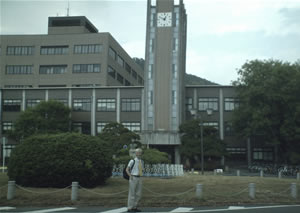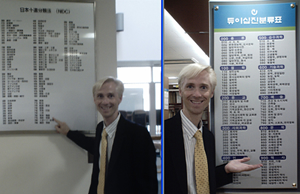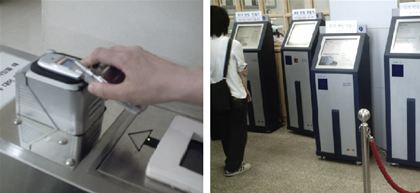|
|
Summer Travel
Journal: Japan & Korea
John Hickok
July 12, 2006
Hello again, colleagues.
The month of June is now over, and with it, my visit to two more countries: Japan
and Korea. Certainly these two countries warrant a full month of visiting each,
but due to the abbreviated time for summer, I had to combine them.
JAPAN
Japan’s higher education environment is frequently ranked at the top within
Asia. And indeed, there is a longstanding history of quality higher education
in Japan. But does this extend to the library? Well, yes and no. As for facilities,
the top national university libraries are quite complete: modern buildings with
high technology (wifi, etc.), strong showings of online catalog software and
Western academic databases (Web of Science, etc.), and more. The prefecture and
smaller (city) university facilities are also strong, just with less items — database
subscriptions, etc.
When it comes to reference and instruction service, however, there are several
differences between Japan and the United States. One example is that many Japanese
universities combine their reference and circulation desks. While this may seem
like an efficient consolidation of services, it makes the quality reference service — due
to the noise, traffic, etc. — more difficult. Another example is the training
of librarians. While most U.S. academic librarians have a MLIS after their bachelor’s
degree, a large percentage of Japanese librarians have a “Shisho” (certificate)
after their bachelor’s. This certificate is obtained by completing some
courses through an “extended education” department — often
part-time. Thus, the librarian title does not carry the same academic rigor as
its American counterparts.
Two more examples in Japan are not unique to Japan only — they are typical
of other Asian countries, too. First, the library director is almost always a
non-librarian; that is, a professor from an academic department assigned by the
university president to “preside over” the library for a two- to
three- year term. Why doesn’t a librarian preside? Primarily, historical
tradition — that a faculty member must administer the library. However,
this system makes innovation and long-term planning difficult; not having the
library managed by a librarian who understands library issues.
Second, library instruction is not often promoted as an ongoing service of the
library. New student orientations are certainly given, but continual education — weekly
workshops, customized sessions for professors, etc. — are much less common.
One explanation for this phenomenon is the nature of Japanese undergraduate education:
it is still heavily “memorize and take an exam” rather than exploring
library resources and preparing an independent research paper. Thus, with undergraduate
students not needing library resources as much, the library doesn’t have
the demand to provide so much instruction.
In all, the academic libraries I visited were impressive structures for their
collections, automation, technology and facilities. As reference and instruction
services improve, in proportion, this will help Japanese academic libraries develop
more to their potential.
KOREA
Many of characteristics I outlined for Japan, also exist in Korea. Korean academic
libraries — in terms of their buildings and facilities — were mightily
impressive! I saw some of the most modern and high-tech libraries in all of my
travels. For example, one library was almost a perfect replica of the U.S. Library
of Congress architecture, and another library was so high tech with computers/wi-fi/touchscreens
and more, it looked more like a R&D lab than a library.
However, several of the same issues in Japan, are also common in Korea. Library
directors were typically outside appointees, undergraduate curriculum rarely
involved library research, instruction was not often ongoing, and more.
Two characteristics in Korea were different from Japan. First, librarians in
Korea typically earn a bachelor’s in library and information science (BLIS),
and then go directly into employment. A problem with this is that librarians
in Korea have very little subject specialization — not having a subject
degree. Second, a main/single/consolidated reference desk is not the norm in
Korea. Rather, multiple references desks — one on every floor, or in every
collection area — is much more the trend. I observed that while this may
have a wider service appeal, it was quite labor intensive, keeping librarians
at desks and allowing less time for more advanced projects and planning — bibliographies,
instruction lessons, Web guides, etc.
In all, Korea’s libraries are fantastic in their facilities, and like Japan,
as reference and instruction outreach improves correspondingly, the libraries’ role
as an active information-consultation-learning center, will be more fully realized.
For July, my final country visit, I am headed to Taiwan.
Regards from Asia,
John
Me in Japan, visiting Okayama University’s
library. Yes, that’s
a backpack I have, filled with all kinds of sample brochures and handouts!

|
Photos of me viewing Japan’s Nippon Decimal Classification (NDC)
and Korea’s Korean Decimal Classification (KDC). Interestingly,
many libraries will use Library of Congress or DDC or Western materials,
but NCD or KDC for their respective language materials.
Examples of the hi-tech library features in both countries, including a student
signing in to the library using their mobile phone (student IDs are embedded
into their phones), and a touch screen reservation system in the lobby for study
carrels and group study rooms.
Read more about John's Travels...
Mongolia
Taiwan
China |





 Produced by the Office of Public Affairs at California State University, Fullerton.
Contact the
Produced by the Office of Public Affairs at California State University, Fullerton.
Contact the